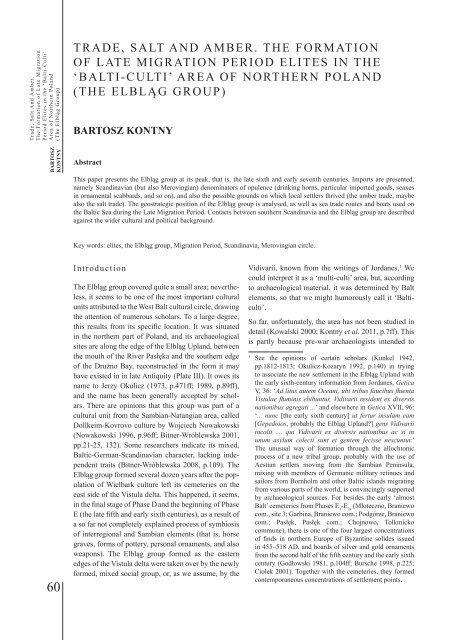BALTICA17 - KlaipÄdos universitetas
BALTICA17 - KlaipÄdos universitetas
BALTICA17 - KlaipÄdos universitetas
Create successful ePaper yourself
Turn your PDF publications into a flip-book with our unique Google optimized e-Paper software.
Trade, Salt And Amber.<br />
The Formation of Late Migration<br />
Period Elites in the ‘Balti-Culti’<br />
Area of Northern Poland<br />
(The Elbląg Group)<br />
TRADE, SALT AND AMBER. THE FORMATION<br />
OF LATE MIGRATION PERIOD ELITES IN THE<br />
‘BALTI-CULTI’ AREA OF NORTHERN POLAND<br />
(THE ELBLĄG GROUP)<br />
BARTOSZ KONTNY<br />
BARTOSZ<br />
KONTNY<br />
Abstract<br />
This paper presents the Elbląg group at its peak, that is, the late sixth and early seventh centuries. Imports are presented,<br />
namely Scandinavian (but also Merovingian) denominators of opulence (drinking horns, particular imported goods, seaxes<br />
in ornamental scabbards, and so on), and also the possible grounds on which local settlers thrived (the amber trade, maybe<br />
also the salt trade). The geostrategic position of the Elbląg group is analysed, as well as sea trade routes and boats used on<br />
the Baltic Sea during the Late Migration Period. Contacts between southern Scandinavia and the Elbląg group are described<br />
against the wider cultural and political background.<br />
Key words: elites, the Elbląg group, Migration Period, Scandinavia, Merovingian circle.<br />
60<br />
Introduction<br />
The Elbląg group covered quite a small area; nevertheless,<br />
it seems to be one of the most important cultural<br />
units attributed to the West Balt cultural circle, drawing<br />
the attention of numerous scholars. To a large degree,<br />
this results from its specific location. It was situated<br />
in the northern part of Poland, and its archaeological<br />
sites are along the edge of the Elbląg Upland, between<br />
the mouth of the River Pasłęka and the southern edge<br />
of the Drużno Bay, reconstructed in the form it may<br />
have existed in in late Antiquity (Plate III). It owes its<br />
name to Jerzy Okulicz (1973, p.471ff; 1989, p.89ff),<br />
and the name has been generally accepted by scholars.<br />
There are opinions that this group was part of a<br />
cultural unit from the Sambian-Natangian area, called<br />
Dollkeim-Kovrovo culture by Wojciech Nowakowski<br />
(Nowakowski 1996, p.96ff; Bitner-Wróblewska 2001,<br />
pp.21-25, 132). Some researchers indicate its mixed,<br />
Baltic-German-Scandinavian character, lacking independent<br />
traits (Bitner-Wróblewska 2008, p.109). The<br />
Elbląg group formed several dozen years after the population<br />
of Wielbark culture left its cemeteries on the<br />
east side of the Vistula delta. This happened, it seems,<br />
in the final stage of Phase Dand the beginning of Phase<br />
E (the late fifth and early sixth centuries), as a result of<br />
a so far not completely explained process of symbiosis<br />
of interregional and Sambian elements (that is, horse<br />
graves, forms of pottery, personal ornaments, and also<br />
weapons). The Elbląg group formed as the eastern<br />
edges of the Vistula delta were taken over by the newly<br />
formed, mixed social group, or, as we assume, by the<br />
Vidivarii, known from the writings of Jordanes. 1 We<br />
could interpret it as a ‘multi-culti’ area, but, according<br />
to archaeological material, it was determined by Balt<br />
elements, so that we might humorously call it ‘Balticulti’.<br />
So far, unfortunately, the area has not been studied in<br />
detail (Kowalski 2000; Kontny et al. 2011, p.7ff). This<br />
is partly because pre-war archaeologists intended to<br />
1<br />
See the opinions of certain scholars (Kunkel 1942,<br />
pp.1812-1813; Okulicz-Kozaryn 1992, p.140) in trying<br />
to associate the new settlement in the Elbląg Upland with<br />
the early sixth-century information from Jordanes, Getica<br />
V, 36: ‘Ad litus autem Oceani, ubi tribus faucibus fluenta<br />
Vistulae fluminis ebibuntur, Vidivarii resident ex diversis<br />
nationibus agregati ...’ and elsewhere in Getica XVII, 96:<br />
‘... nunc [the early sixth century] ut fertur insulam eam<br />
[Gepedoios, probably the Elbląg Upland?] gens Vidivarii<br />
incolit .... qui Vidivarii ex diversis nationibus ac si in<br />
unum asylum colecti sunt et gentem fecisse nescuntur.’<br />
The unusual way of formation through the allochtonic<br />
process of a new tribal group, probably with the use of<br />
Aestian settlers moving from the Sambian Peninsula,<br />
mixing with members of Germanic military retinues and<br />
sailors from Bornholm and other Baltic islands migrating<br />
from various parts of the world, is convincingly supported<br />
by archaeological sources. For besides the early ‘almost<br />
Balt’ cemeteries from Phases E 1<br />
-E 2a<br />
(Młoteczno, Braniewo<br />
com., site 3; Garbina, Braniewo com.; Podgórze, Braniewo<br />
com.; Pasłęk, Pasłęk com.; Chojnowo, Tolkmicko<br />
commune), there is one of the four largest concentrations<br />
of finds in northern Europe of Byzantine solides issued<br />
in 455–518 AD, and hoards of silver and gold ornaments<br />
from the second half of the fifth century and the early sixth<br />
century (Godłowski 1981, p.104ff; Bursche 1998, p.225;<br />
Ciołek 2001). Together with the cemeteries, they formed<br />
contemporaneous concentrations of settlement points.

















